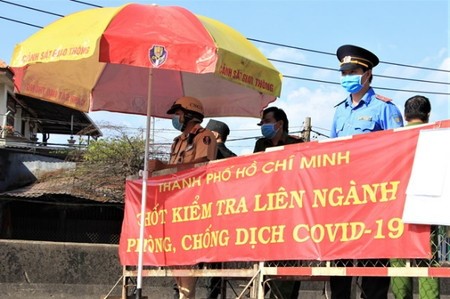【20-09】2020年ベトナムにおける新型コロナウイルスのパンデミック状況
2020年5月13日 さくらサイエンスプラン(SSP)同窓生
科学技術振興機構(JST)中国総合研究・さくらサイエンスセンター(CRSC)では、2014年度より日本・アジア青少年サイエンス交流事業「さくらサイエンスプラン(SSP)」を実施し、科学技術交流を通じてわが国とアジアを中心とした各国・地域との連携・協力関係を深めてまいりました。各種報道の通り、現在、世界中で新型コロナウイルス感染症の流行が拡大しておりますが、本コーナーでは「さくらサイエンスプラン」に参加している各国・地域の関係機関・関係者より現地の新型コロナウイルス感染症について、その状況や対策等をリポートします。
SARS-CoV-2ウイルスによる新型コロナウイルスは、2020年1月23日にベトナムで初めて確認されました。4月19日現在、ベトナムでは268人の陽性患者が確認されており、そのうち202人が退院し、未だに死亡者は出ていません。ハノイは現在、112人の患者が確認されており、ベトナム内で最も被害を受けた都市となっています。
今回の新型コロナウイルスの感染拡大において、ベトナムは世界で最も伝染病のコントロールにおいて優秀な対策を取った国として挙げられています。ベトナムは、流行地域から人々を隔離、監視、制限し、国境を閉鎖すると共に、医療的緊急事態宣言の実施を展開するための措置を実施しています。混雑を制限し、多くの場所では、体温の測定、消毒剤を配備し、公共の場所では無料でマスクを配布するなどの措置を取り、コントロールを強化しています。国内旅行や貿易も制限されています。ベトナムは、世界のほとんどの流行国と同様に、社会的・経済的に大きな影響を受けています。
ステージ1には、新型コロナウイルスの最初の16例が含まれています。最初に確認されたのは武漢市からハノイへ家族と面会するために渡航し、ホーチミン市のチョー・レイ病院に入院した66歳の中国人男性(症例番号1)と、前述の中国人男性とニャチャンで出会った際に父親から感染したとみられる28歳の息子(症例番号2)の2人。2月1日、カーンホア省で25歳の女性(症例番号6)が新型コロナウイルス感染者と確認されました。彼女はとある受付嬢と接触したが、この受付嬢も中国人の父子2人と濃厚接触していたことが後に発覚した(症例#1と#2)。特筆すべきは、これがベトナム国内での初の感染例であり、グエン・スアン・フック首相がベトナム国内での初の感染例であることを発表し、国境線の引き締めを決定するに至った出来事でもあります。2月25日に、症例番号16は新型コロナウイルスから回復し、退院しました。これは、ベトナムでの最初の16例のケースが退院した最後のケースでもあります。新型コロナウイルスの最初の16例では、乳幼児や高齢者、多くの基礎疾患を持つ人など、多岐にわたる人々が感染していました。病院は相談会を組織し、各患者に最適な治療を提供し、基礎疾患をコントロール、新型コロナウイルスの治療を成功させるための環境作りを徹底的に行いました。また、ウイルスの早期発見のための分離・検査法も治療の成功に貢献しています。
ステージ2には、海外からの渡航例も含まれています。3月6日夜、ハノイ市は26歳の女性が新型コロナウイルスの陽性となった最初の症例を発表しました。ベトナムでの感染例(#17)はこれで17例目となります。症例番号17との間で、多くの濃厚接触例や隔離例が報告されていますが、ベトナムでは新たな陽性患者が報告されることなく、22日間陽性患者の報告がない日が続きました。3月19日夜には、全国の患者数は85人に増加しました。
地域コミュニティでの感染拡大の危険性もあるステージ3では、 3月20日、保健省は、新型コロナウイルスの患者2人、症例番号86、87は、バッハマイ病院の女性看護師2人で、いずれも新型コロナウイルスの患者と接触しておらず、感染経路が不明ということを発表しました。3月21日には、ベトナムは22日0:00からすべての外国人の入国を一時的に停止し、入国したすべての人々については14日間の集中隔離を行うことを発表。ベトナムは4月1日0:00から15日間の全国範囲における自主隔離を実施しました。同日、グエン・スアン・フック首相は、これまでの2020年2月1日の感染病流行宣言に代わり、新型コロナウイルスの全国的な感染拡大を発表しました。
新型コロナウイルスのパンデミックのため、ベトナムでは感染拡大を制限するために全ての教育機関が休校となっています。私自身も、学校には行っていませんが、インターネットを介してオンラインで学生に教えることができます。ベトナムでは、ウイルスの拡散を制限するために自主隔離を実施。その間、政府は公共交通機関の運行を禁止し、ショッピングモールや飲食店を閉鎖し、集会を避け(スーパーは開いている)、外国人の入国を禁止し、国内の渡航を最小限に抑えています。また、外出や集会を制限し(食料を買うなど絶対に必要なときだけ外出し、テレワークを推奨)、マスクを着用する、石鹸でこまめに手を洗う、異物に触れるときは手指消毒剤を使用するなどの厳重な注意を出しています。違反した場合は政府の制裁の対象となります。以上のことは、病気の蔓延を抑えるために必要な対策です。

図1:ベトナムにおける新型コロナウイルスの状況
出典:ベトナム保健省、2020年4月19日更新

図2:ベトナムの機能部隊が近隣省からホーチミン市へ渡航する人々の検診のために検問所を設置
(出典:https://thanhnien.vn/thoi-su/tphcm-thuc-hien-cach-ly-xa-hoi-chong-covid-19-nhu-the-nao-trong-tuan-toi-1212007.html)
(2020年4月19日)
※本稿はさくらサイエンスプラン同窓生からの寄稿文を中国総合研究・さくらサイエンスセンターが日本語訳したものである。
●英文オリジナル
2020 CORONAVIRUS PANDEMIC IN VIETNAM
(April 19, 2020)
The COVID-19 pandemic caused by SARS-CoV-2 virus was first confirmed in Vietnam on January 23, 2020. As of April 19, Vietnam recorded 268 cases, of which 202 patients were discharged and no deaths were recorded. Hanoi is currently the most affected city with 112 confirmed cases.
Vietnam is cited as one of the best-organised epidemic control programs in the world. Vietnam has implemented measures to isolate, monitor and restrict people from epidemic areas, close borders and deploy the implementation of medical declarations. Crowded people restricted, and many places take measures such as measuring body temperature, equipping disinfectants, distributing masks for free in public places, tightening control. Domestic travel and trade is also limited. Like most of the countries affected by the epidemic in the world, Vietnam has suffered a significant social and economic impact.
Stage 1 includes the first 16 cases of Covid-19. The first two confirmed cases were admitted to Cho Ray Hospital, Ho Chi Minh City, including a 66-year-old Chinese man (case # 1) traveling from Wuhan to Hanoi to visit his son, and his 28-year-old son (case # 2), who is believed to have contracted the disease from his father when they met in Nha Trang. On February 1, a 25-year-old woman (case # 6) was identified with corona virus infection in Khanh Hoa province. She came into contact with a receptionist and involved two Chinese father and son (cases # 1 and 2). Notably, this is the first case of domestic transmission in Vietnam, leading to Prime Minister Nguyen Xuan Phuc announcing the outbreak in Vietnam and making a decision to tighten the border. February 25, case # 16 was declared rehab and discharged. This is also the last case in the first 16 cases in Vietnam discharged. In the first 16 cases of SARS-CoV-2, Vietnam had many cases of patients, including infants, the elderly and people with many underlying conditions. Hospitals have organized a consultation, offering the best treatment regimen for each patient, controlling the underlying disease, helping create opportunities for successful corona virus treatment. In addition, isolation and testing methods for early detection of viruses also contribute to the success of treatment.
Stage 2 includes cases of invasion from abroad. On the evening of March 6, Hanoi announced the first case positive for corona virus, a 26-year-old woman. This is the 17th case of infection (# 17) in Vietnam. Case # 17 has terminated the chain of 22 consecutive days without new cases being reported in Vietnam, although there have been many suspected and isolated cases during that period. On the evening of March 19, the total number of patients nationwide increased to 85.
Stage 3 with risk of spreading in the community. On March 20, the Ministry of Health announced that 2 patients of Covid-19, case #86 and #87 were 2 female nurses at Bach Mai Hospital with a history of epidemiology without showing the source of infection when both didn't contact with Covid-19 patients. On March 21, Vietnam temporarily suspended entry for all foreigners from 0:00 on March 22, and concentrated isolation for 14 days in all cases of entry. From 0:00 on April 1, Vietnam implemented social isolation within 15 days. On the same day, Prime Minister Nguyen Xuan Phuc announced the nationwide outbreak of COVID-19, replacing the previous outbreak decision on February 1, 2020.
Because of the COVID-19 pandemic, all schools and universities in Vietnam are closed to limit the spread of infection. Although I don't go to school, I can teach students online via the internet. In Vietnam, implementation of social isolation to limit the spread of the virus. During that time, the government also banned the operation of public transport, closed shopping malls and eateries, avoided gathering (just opening food supermarkets), and prohibited entry of foreigners, minimize domestic flights ... In addition, limit going out and gathering a lot of people (people only go out when absolutely necessary such as buying food, and can still work online at home), take serious precautions to wear a mask, wash hands with soap often, and use hand sanitizer when touching foreign objects. Cases of non-compliance are sanctioned. All of the above are necessary measures to limit the spread of disease.
Contributed by an alumnus of SSP